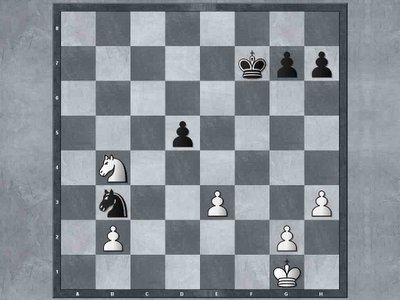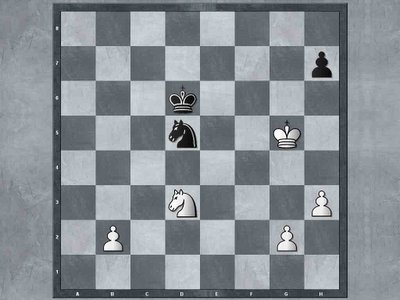First analysed game
[White "Bark"][Black "?"]
[Result "1-0"]
[ECO "C92"]
[WhiteElo "1956"]
[BlackElo "1958"]
1. e4 e5 2. Nf3 Nc6 3. Bb5
This is Ruy Lopez. I must admit that I don't know openings very well. My endings are strong.
3... a6
Morphy defense
4. Ba4 Nf6 5. O-O

This is not gambit play at all. The point is that black can't gain a pawn as the e-file will soon be opened and white will take back the pawn. For example... If 5...Nxe4 then 6.Re1 Nc5 attacking the bishop 7.Bxc6 removing the defender of the e5 pawn dxc6 8.Nxe5 and white has great discoveries if black doesn't block the e-file.
5... Be7 6. Re1 b5 7. Bb3 d6 8. c3 O-O 9. h3 Be6 10. d4 Bxb3 11. axb3 exd4 12. cxd4 d5 13. e5 Ne4 14. Nc3 f5 15. exf6 Nxf6 16. Bg5 b4 17. Ne2 Ne4 18. Bxe7 Nxe7 19. Nc1 Qd6
This is all well known, main line so there's not so many comments on this. Here I saw I had to do something. Well there's not much room for improvement so I decided I should move my c1 knight to a square where it should be more active in play. I also noticed great outpost squares at c5 and e5. So I played Nd3. This move also supports potential weakness at f2 should my f3 knight ever move.
20. Nd3
 Black played Nf5 (20... Nc6 =)
Black played Nf5 (20... Nc6 =)I thought for a while and made a plan. His c7 pawn is weak so i should attack it somehow. I came up with the idea of placing my queen on c2 and then backing her up with rook move to c1. So I played it.
21. Qc2 (21. Rc1 c6 =)
Fritz immediately found Qb6 after my move. That would have been very complicated to defend but fortunately my opponent wasn't Chessbase's Fritz. :)
21... Rad8 (21... Qb6 !?)
Black played this move but I couldn't figure out what's it's purpose. It doesn't attack anything, doesn't defend and doesn't develop. This is usualy a good square for a rook but we'll see was that any good.
22. Nc5
Now this is chess blindness. I didn't do the calculation and made this bad move. What does it do? We'll see what my opponent played. But on the other hand I was inconsistent with my plan. Maybe I tought for so long that I forgot my plan? :) The move that I planned but never played was rook to c1 and that's Fritz's suggestion too. Making Nc5 cost me a pawn.
(22. Rac1 !?+= {is an interesting idea - this is a comment from Fritz, very rich vocabulary :) }) 22... Nxd4 =+ 23. Nxd4 Qxc5 24. Qxc5 Nxc5

Black first exchanged his knight for my pawn but this pawn was defender of the c5 knight so he removed the defender and made exchanges that led to black being a pawn up. I'm down a pawn.... Ok. Move on. It's not end of the world. I needed to figure out how to continue. But wait a minute!! I'm not even losing a pawn if I play Rec1!! He can't play Ne6 because my knight guards it. Instead I played a move I wouldn't play in most games.
25. Ne6
When down a pawn you should try to exchange the pawns not pieces. I did a fundamental error. I initiated the exchange myself. In the analysis I slaped my forehead.
(25. Rec1 Nd3 26. Rxc7 Rxf2 = (26... Nxf2 ? 27. Ne6 (27. Rxa6 ?! Rde8 ) 27... Rc8 28. Rxc8 Nxh3+ 29. gxh3 Rxc8 30. Rxa6 ))
You can see how Fritz sees it. Now interesting thing happened. My opponent didn't exchange but...
25... Nxb3 (25... Nxe6 26. Rxe6 Rfe8 27. Raxa6 Rxe6 28. Rxe6 Kf7 )
Fritz gives this line where black is better after the exchanges because he has passed pawn, I have doubled pawns and kingside pawn majority that can't be utilized yet. My opponent gave me a chance to get back into the game so I took it.
26. Rxa6 Rde8
I decided to chase his knight too.
27. Re3 Rf6
He responded just like me - very agressively. I took his pawn while defending rook at a6.
28. Nxc7 Rxe3 29. fxe3 Rxa6 30. Nxa6
Ok. We exchanged all of problematic pieces and now the material is even. He brought his king into play. Wise choice.
30... Kf7
His pawn is hanging so I'll take it. My position got better after the exchange.
31. Nxb4

He brought his king further up the board to the center.
31... Ke6
It was time for my king too to enter the center. :)
32. Kf2 Kd6 33. Ke2 Nc5
After this I thought my situation was better. Now I preffer the exchage of the knights. I should play Nd3. What can he play? If he exchanges my king will sit on very good square. If he doesn't take his king can no longer move to c5 and e5 because of my knight. So I played it.
34. Nd3 Nd7
He offcourse ran away. I had to come up with a new plan. Yes! I have a passed pawn. I should push it. But it can't progress unsupported so I brought my king over to help.
35. Kd2 Nf6
Yessss..... He's trying something but that won't help. Look at the d4 square. Now isn't it ideal for my king? Centrally placed king is the key to win endgames.
36. Kc3
I thought he'll check me but he did a bad move and made his position even worse.
36... Nd7
Now my position is better but I still have to win it. It won't be easy. Besides Kd4 Fritz suggests b4 too.
37. Kd4

37... g5
Ok. I'm now definitely better. Black was afraid of Nf4 so he stopped that move. Now f5 could be very good square for my king to go to and pick up his kingside pawns. How should I continue? B4 and e4 come to mind. I decided to resolve central tension and play e4. Fritz also suggests e4.
38. e4 dxe4 39. Kxe4
I'm coming in and black can't stop it. He cracks and plays...
39... Nf6+ ? (39... Nf8 was way better)
He gave me the opportunity to reach f5 with my king and that was exactly my plan. So? Kf5!
40. Kf5 Nd5
He could have played Ng8 to cut my king of the h pawn but he made a move that ends the fun for him in this game.
(40... Ke7 {doesn't change the outcome of the game} 41. Kxg5

41... Kf7 42. Kh6 ) 41. Kxg5 Ne7 (41... Ke7 {does not help much} 42. Kh6 )
I didn't want black to get back into the game so I limited his knight play by g4 but Kh6 was good too.
42. g4 (42. Kh6 {and White can already relax} Ke6) 42... Ng8
Ok. You cut me out. But you'll have to move once my b pawn gets dangerous.
43. b4 Kc6 44. Kf5 Ne7+ (44...Kd5 {there is nothing else anyway}) 45. Kf6 Nd5+
Yea. The hell breaks loose. He can't do anything now to prevent my king from taking that h pawn. The rest is only the matter of technique.
46. Kg7 h6 (46... Kb5 {hoping against hope} 47. g5 Kc4) 47. Kxh6 Kb5 48. g5 Kc4
I just ignored this threat because I calculated that he can't stop so many threats. His knight will defend promotion on g-file and his king can't take my knight because he won't be able to stop my b pawn from queening.
49. g6 Ne7 (49... Kxd3 {is not much help} 50. g7 Nxb4 51. g8=Q) 50. g7 Nf5+ 51. Kg6 Ne7+ 52. Kf7 Nf5 53. g8=Q

53... Nh6+ 54. Kg7+ Nxg8 55. Kxg8
This is pretty much over. I'll soon make a queen and black will lose.
55... Kb5 56. h4 Ka6 57. h5 Kb5 58. h6 Kc4 59. h7

59... Kxd3 {If Black now only could play h8Q...}
Even the b pawn will promote. It's easier to mate with 2 queens. Right?
60. b5 Ke4 61. b6 Kf3 62. b7 Ke4 (62... Kg4 {doesn't do any good} 63. h8=Q Kg3 64. b8=Q+ Kg4 65. Qbe5 Kf3 66. Qh1+ Kg4 67. Qhh5#) 63. b8=Q Ke3 (63... Kd4 {does not save the day} 64. h8=Q+ Ke4 65. Qe8+ Kd3 66. Qb2 Kc4 67. Qeb5#) 64. h8=Q Ke2 65. Qf6 Kd3 (65... Ke3 {does not win a prize} 66. Qbe5+ Kd3 67. Qc3+ Ke2 68. Qff3#) 66. Qbd6+ (66. Qb3+ Kd2 67. Qf2+ Kc1 68. Qfe3#) 66... Kc2 67. Qf3 Kb2 (67... Kb1 {does not improve anything} 68. Qfd3+ Ka1 69. Q6a3#) 68. Qd2+ Ka1 69. Qfd1# (69.Qh1#) 1-0

Yes, right. There were faster ways to mate but you don't have to find the fastest one because you have 2 queens. Just watch for a stalemate.
I hope you enjoyed this as much as I did spend time to make this.
See ya soon

0 Comments:
Post a Comment
<< Home